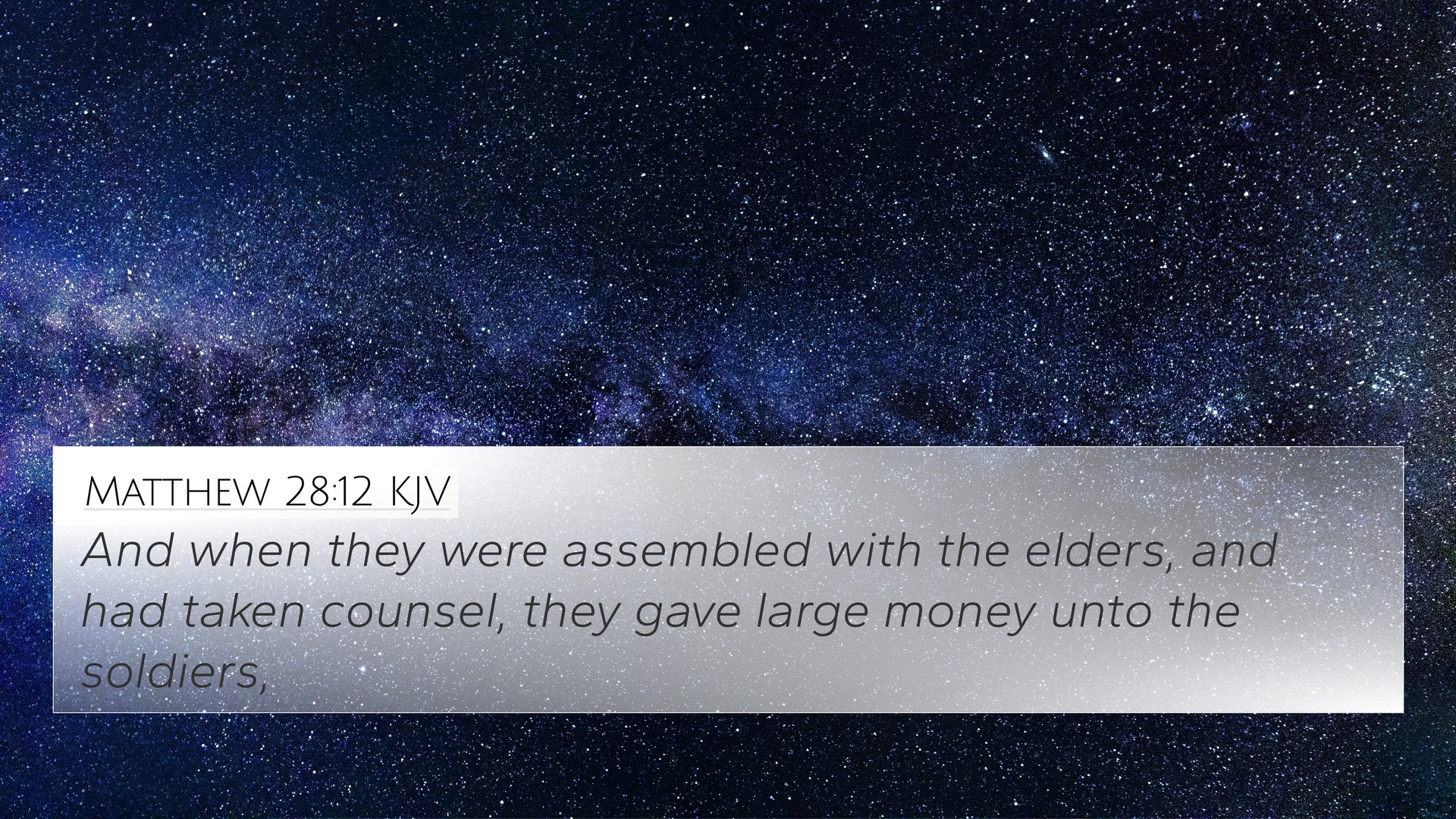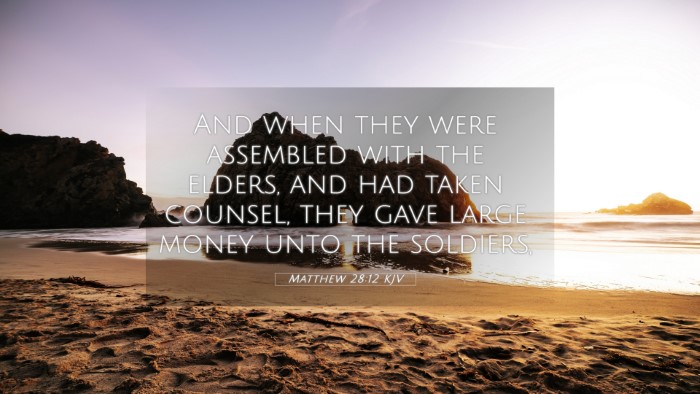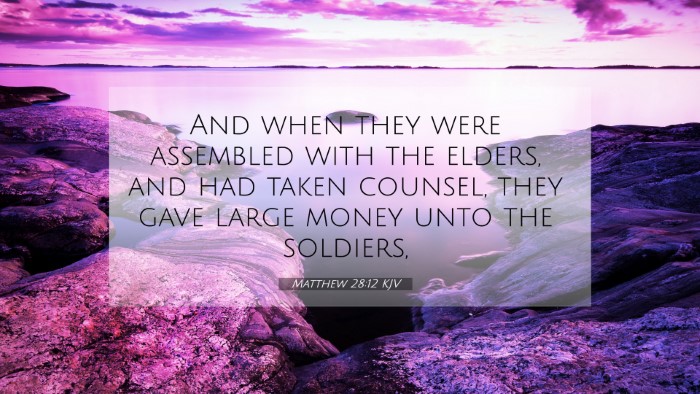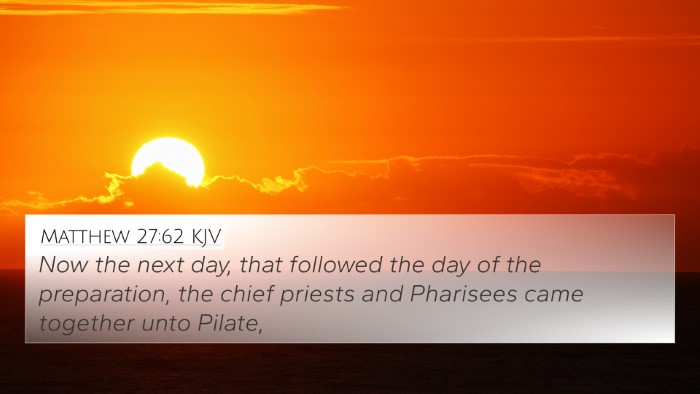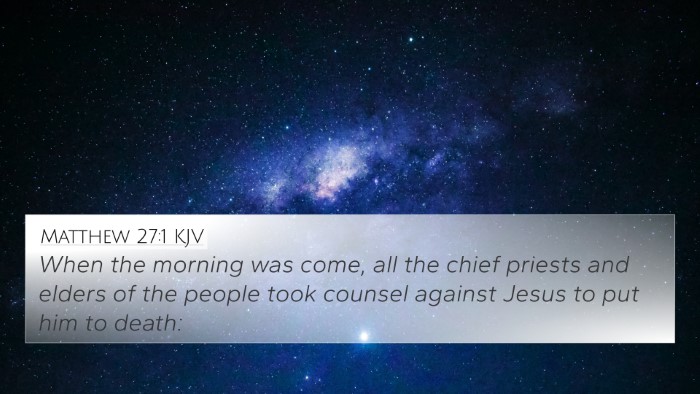Matthew 28:12 Summary and Commentary
Matthew 28:12 states:
"And when they were assembled with the elders and had taken counsel, they gave large money unto the soldiers."
This passage occurs right after the resurrection of Jesus, detailing the actions taken by the chief priests in response to the reported resurrection. A combination of insights from various public domain commentaries, such as those by Matthew Henry, Albert Barnes, and Adam Clarke, reveals deep interpretations of the event and its implications.
Contextual Background
In the aftermath of the resurrection, there was a concerted effort by the Jewish leaders to discredit the miraculous event. The soldiers guarding the tomb had experienced an extraordinary event they could not explain, leading to intense fear (Matthew 28:4). The elders, recognizing the implications of this event, sought to suppress the truth of Jesus’ resurrection.
Commentary Insights
- Matthew Henry's Commentary: Henry interprets this act of bribing the soldiers as a symbol of the lengths to which the religious authorities would go to maintain their authority. The elders’ agreement to provide money signifies their acknowledgment of the miracle yet choosing deception over truth.
- Albert Barnes' Notes: Barnes emphasizes that the elders, in their desperate attempt to deny the resurrection, demonstrated their unwillingness to accept the evidence. The sum of money given to the soldiers is indicative of their collusion and the severe implications of their actions for the spreading Christian faith.
- Adam Clarke's Commentary: Clarke delves into the nature of the bribe, suggesting it reflects the high stakes of the situation. He believes it was a desperate strategy that not only attempts to quell the fear of the soldiers but also aimed to prevent the truth from spreading about Jesus' triumph over death.
Thematic Revelations
This passage raises essential themes regarding truth, deception, and accountability. The intentional misrepresentation of facts by the elders reveals the human propensity to resist divine truths when they challenge established power structures.
Additionally, it prompts reflections on moral integrity in the face of truth. The soldiers are put in a position where they are forced to choose between fidelity to truth and monetary gain.
Cross References
- Matthew 27:63-64: The request of the Pharisees for the tomb to be made secure reflects their fear of Jesus’ claims of resurrection.
- Luke 24:9-11: The initial disbelief from the apostles when the women report the resurrection is a crucial parallel.
- Acts 1:3: This verse highlights the post-resurrection appearances of Jesus, revealing that many witnessed Him alive.
- John 20:19-21: Jesus' appearance to His disciples reinforces the truth of the resurrection amidst fear.
- Matthew 28:14: The explicit instruction to tell people that the disciples stole the body continues the narrative of deception.
- 1 Corinthians 15:14: This epistle underscores the importance of the resurrection in the Christian faith, affirming the gravity of this event.
- Acts 4:2-3: The continuing persecution from Jewish leaders against the apostles for preaching the resurrection demonstrates the power struggle at play.
- Hebrews 12:2: Examining Jesus as the author and finisher of our faith brings the resurrection into a fuller context of redemption.
- Mark 16:11: Another instance of disbelief among the disciples is crucial in understanding their emotional state following the resurrection.
- Matthew 28:11: This verse describes the soldiers reporting to the chief priests, indicating their role in the supposed cover-up.
Conclusion
Matthew 28:12 encapsulates the tension between truth and deception during one of the most pivotal moments in Christian history—the resurrection of Jesus Christ. The commentary and cross-references provide a collective understanding that frames the actions of the religious leaders as not just an attempt to suppress a truth but as resistance against the establishment of a transformative new covenant through Christ. As believers study this passage, they are invited to reflect on the implications of truth in their lives and the challenges posed by a world that often prioritizes authority and tradition over divine revelation.
Tools for Deepening Understanding
For further study on Biblical truths and interconnections, readers may consider:
- Bible concordance for identifying themes and topics.
- Bible cross-reference guide to facilitate linking scriptures.
- Comprehensive Bible cross-reference materials for deeper insights.
- Cross-referencing Bible study methods for effective examination of relationships between verses.
